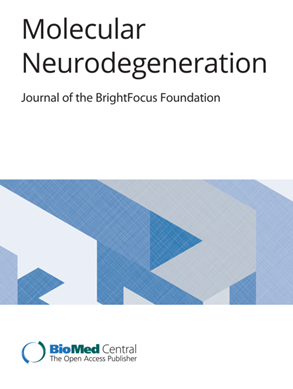Cell-specific transcriptional signatures of vascular cells in Alzheimer’s disease: perspectives, pathways, and therapeutic directions
IF 17.5
1区 医学
Q1 NEUROSCIENCES
引用次数: 0
Abstract
Alzheimer’s disease (AD) is a debilitating neurodegenerative disease that is marked by profound neurovascular dysfunction and significant cell-specific alterations in the brain vasculature. Recent advances in high throughput single-cell transcriptomics technology have enabled the study of the human brain vasculature at an unprecedented depth. Additionally, the understudied niche of cerebrovascular cells, such as endothelial and mural cells, and their subtypes have been scrutinized for understanding cellular and transcriptional heterogeneity in AD. Here, we provide an overview of rich transcriptional signatures derived from recent single-cell and single-nucleus transcriptomic studies of human brain vascular cells and their implications for targeted therapy for AD. We conducted an in-depth literature search using Medline and Covidence to identify pertinent AD studies that utilized single-cell technologies in human post-mortem brain tissue by focusing on understanding the transcriptional differences in cerebrovascular cell types and subtypes in AD and cognitively normal older adults. We also discuss impaired cellular crosstalk between vascular cells and neuroglial units, as well as astrocytes in AD. Additionally, we contextualize the findings from single-cell studies of distinct endothelial cells, smooth muscle cells, fibroblasts, and pericytes in the human AD brain and highlight pathways for potential therapeutic interventions as a concerted multi-omic effort with spatial transcriptomics technology, neuroimaging, and neuropathology. Overall, we provide a detailed account of the vascular cell-specific transcriptional signatures in AD and their crucial cellular crosstalk with the neuroglial unit. Endothelial and mural cell types mediate dysregulated transcriptional pathways and cell-cell interactions in AD. The neurovascular unit (NVU) is composed of various cell types, including endothelial cells, mural cells (pericytes, smooth muscle cells), fibroblast neurons, microglia, and astrocytes. Dysregulated transcriptional pathways in AD involve multiple pathways, notably immune responses, and angiogenesis common to both endothelial and mural cells. Additionally, pathways involving neuroinflammation and amyloid clearance are prominent in endothelial cell types, while mural cells exhibit pathways related to growth factors, cytoskeletal remodeling and synaptic function. In addition, crosstalk within the NVU and gliovascular unit (GVU) is altered in AD, with altered cell-cell communication evident, with increased interactions between endothelial cells, pericytes, neurons, and microglia, and decreased interactions between endothelial cells, fibroblasts, astrocytes, and neurons. Figure created with BioRender.com. Abbreviations: AD, Alzheimer's disease; NVU, Neurovascular unit; CNS, Central Nervous System.阿尔茨海默病血管细胞的细胞特异性转录特征:观点、途径和治疗方向
阿尔茨海默病(AD)是一种使人衰弱的神经退行性疾病,其特征是严重的神经血管功能障碍和脑血管系统中显著的细胞特异性改变。高通量单细胞转录组学技术的最新进展使人类脑血管系统的研究达到了前所未有的深度。此外,研究人员还对脑血管细胞(如内皮细胞和壁细胞)及其亚型进行了研究,以了解阿尔茨海默病的细胞和转录异质性。在这里,我们概述了从最近的人类脑血管细胞单细胞和单核转录组学研究中获得的丰富转录特征及其对AD靶向治疗的意义。我们利用Medline和Covidence进行了深入的文献检索,通过重点了解AD和认知正常老年人脑血管细胞类型和亚型的转录差异,确定了在人类死后脑组织中利用单细胞技术的相关AD研究。我们还讨论了AD中血管细胞和神经胶质细胞之间的细胞串扰受损,以及星形胶质细胞。此外,我们将人类AD大脑中不同的内皮细胞、平滑肌细胞、成纤维细胞和周细胞的单细胞研究结果与空间转录组学技术、神经影像学和神经病理学相结合,强调了潜在的治疗干预途径。总的来说,我们提供了AD中血管细胞特异性转录特征的详细描述,以及它们与神经胶质细胞单位的关键细胞串扰。内皮细胞和壁细胞类型介导AD中失调的转录途径和细胞间相互作用。神经血管单元(NVU)由不同类型的细胞组成,包括内皮细胞、壁细胞(周细胞、平滑肌细胞)、成纤维细胞神经元、小胶质细胞和星形胶质细胞。阿尔茨海默病的转录途径失调涉及多种途径,尤其是免疫反应,以及内皮细胞和壁细胞共同的血管生成。此外,涉及神经炎症和淀粉样蛋白清除的途径在内皮细胞类型中很突出,而壁细胞则表现出与生长因子、细胞骨架重塑和突触功能相关的途径。此外,AD患者NVU和胶质血管单位(GVU)内的串扰发生改变,细胞间通讯明显改变,内皮细胞、周细胞、神经元和小胶质细胞之间的相互作用增加,内皮细胞、成纤维细胞、星形胶质细胞和神经元之间的相互作用减少。用BioRender.com创建的图。缩写:AD,阿尔茨海默病;NVU,神经血管单元;中枢神经系统。
本文章由计算机程序翻译,如有差异,请以英文原文为准。
求助全文
约1分钟内获得全文
求助全文
来源期刊

Molecular Neurodegeneration
医学-神经科学
CiteScore
23.00
自引率
4.60%
发文量
78
审稿时长
6-12 weeks
期刊介绍:
Molecular Neurodegeneration, an open-access, peer-reviewed journal, comprehensively covers neurodegeneration research at the molecular and cellular levels.
Neurodegenerative diseases, such as Alzheimer's, Parkinson's, Huntington's, and prion diseases, fall under its purview. These disorders, often linked to advanced aging and characterized by varying degrees of dementia, pose a significant public health concern with the growing aging population. Recent strides in understanding the molecular and cellular mechanisms of these neurodegenerative disorders offer valuable insights into their pathogenesis.
 求助内容:
求助内容: 应助结果提醒方式:
应助结果提醒方式:


